Taxation Theory, Practice & Law: Analysis of Tax Cases and Regulations
VerifiedAdded on 2019/10/31
|10
|2254
|159
Report
AI Summary
This report provides a detailed analysis of various taxation issues, including capital gains, fringe benefits tax, and tax assessment. It begins by examining the computation of capital gains and losses based on Section 108-10 of the ITAA 1997, including scenarios involving the sale of assets and the treatment of collectable losses. The report then delves into the computation of Fringe Benefit Tax (FBT) under the Fringe Benefit Tax Act 1986, specifically addressing the taxable value of loan fringe benefits and the impact of statutory and actual interest rates. Furthermore, it explores the distribution of losses among joint owners of rental properties, referencing relevant rulings and case law like FC of T v McDonald. The report also analyzes the case of IRC v Duke Westminster (1936), discussing the principles of tax avoidance and the rights of taxpayers. Finally, it assesses the tax implications of cutting timber, referencing Subsection 6 (1) of the ITAA 1936 and relevant rulings, determining whether income from forestry activities is considered primary production for tax purposes. The report concludes with comprehensive references to support the analysis.
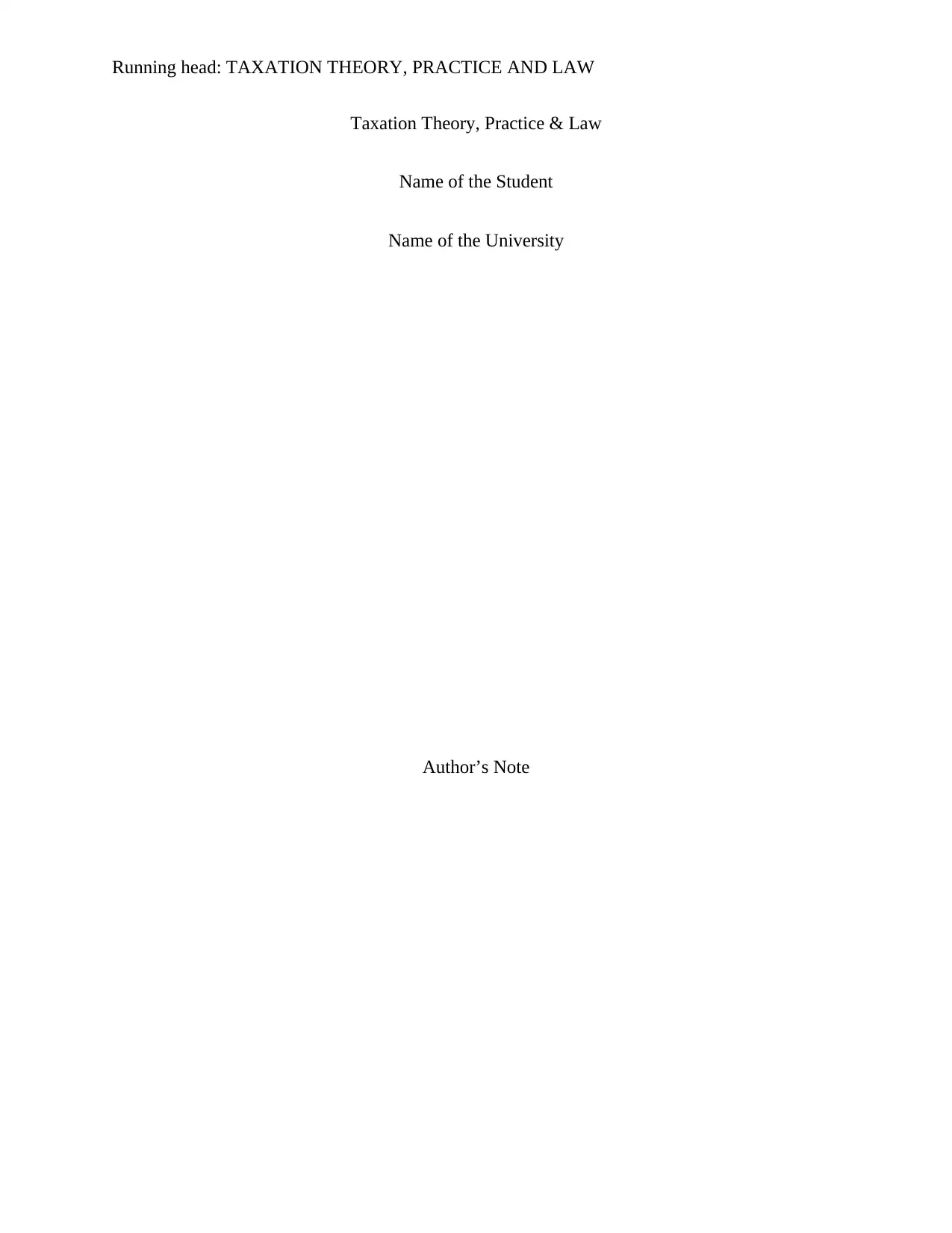
Running head: TAXATION THEORY, PRACTICE AND LAW
Taxation Theory, Practice & Law
Name of the Student
Name of the University
Author’s Note
Taxation Theory, Practice & Law
Name of the Student
Name of the University
Author’s Note
Paraphrase This Document
Need a fresh take? Get an instant paraphrase of this document with our AI Paraphraser
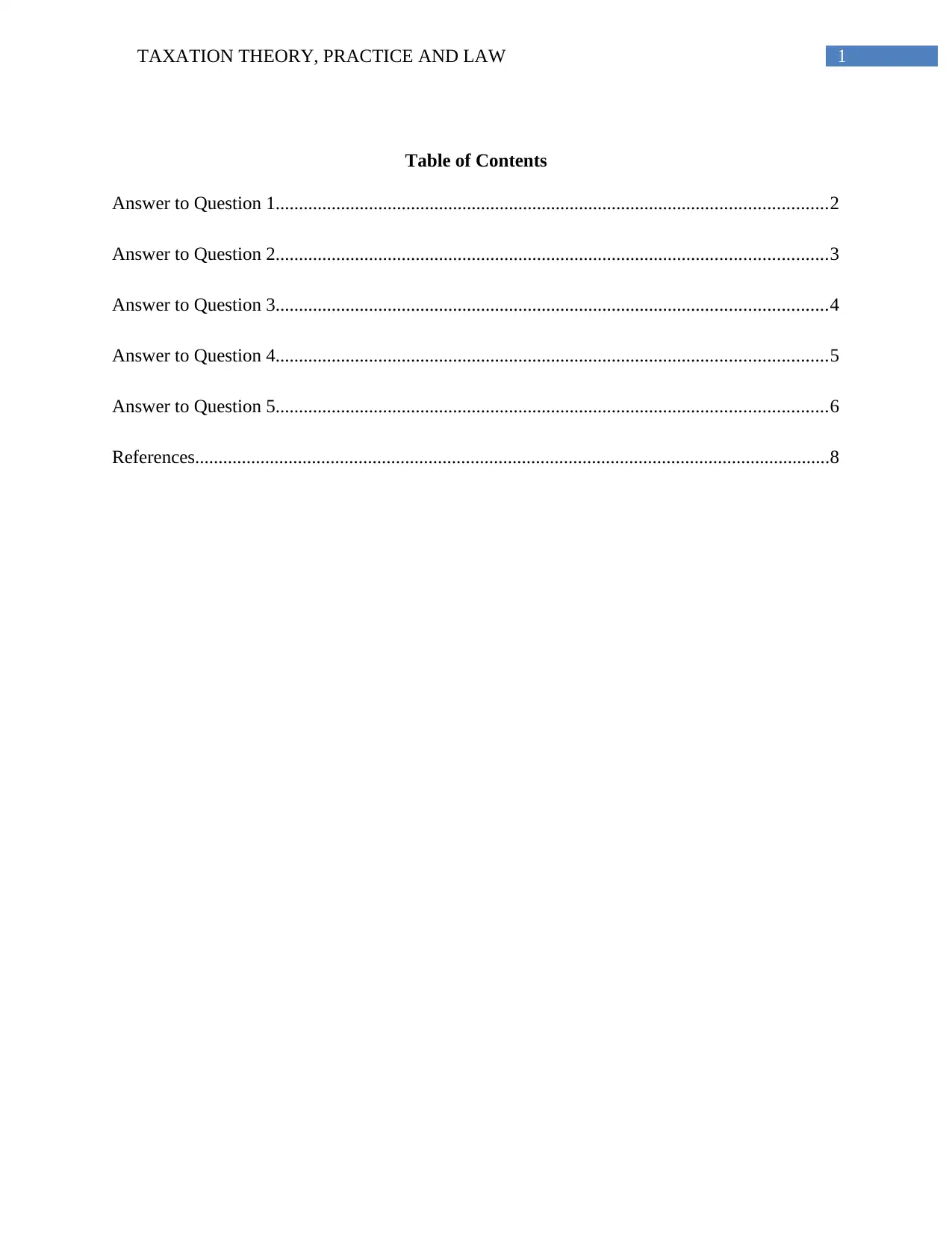
1TAXATION THEORY, PRACTICE AND LAW
Table of Contents
Answer to Question 1......................................................................................................................2
Answer to Question 2......................................................................................................................3
Answer to Question 3......................................................................................................................4
Answer to Question 4......................................................................................................................5
Answer to Question 5......................................................................................................................6
References........................................................................................................................................8
Table of Contents
Answer to Question 1......................................................................................................................2
Answer to Question 2......................................................................................................................3
Answer to Question 3......................................................................................................................4
Answer to Question 4......................................................................................................................5
Answer to Question 5......................................................................................................................6
References........................................................................................................................................8
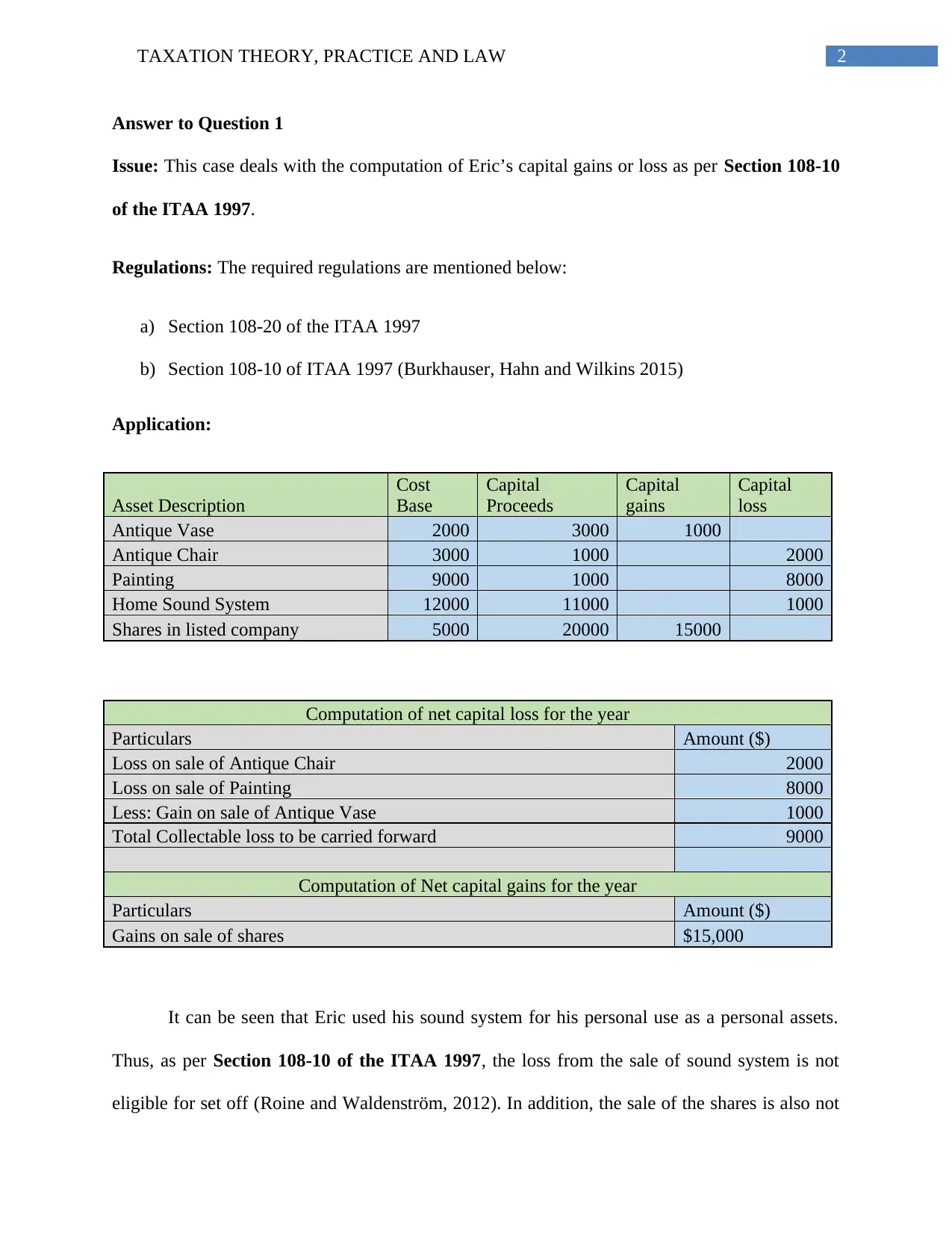
2TAXATION THEORY, PRACTICE AND LAW
Answer to Question 1
Issue: This case deals with the computation of Eric’s capital gains or loss as per Section 108-10
of the ITAA 1997.
Regulations: The required regulations are mentioned below:
a) Section 108-20 of the ITAA 1997
b) Section 108-10 of ITAA 1997 (Burkhauser, Hahn and Wilkins 2015)
Application:
Asset Description
Cost
Base
Capital
Proceeds
Capital
gains
Capital
loss
Antique Vase 2000 3000 1000
Antique Chair 3000 1000 2000
Painting 9000 1000 8000
Home Sound System 12000 11000 1000
Shares in listed company 5000 20000 15000
Computation of net capital loss for the year
Particulars Amount ($)
Loss on sale of Antique Chair 2000
Loss on sale of Painting 8000
Less: Gain on sale of Antique Vase 1000
Total Collectable loss to be carried forward 9000
Computation of Net capital gains for the year
Particulars Amount ($)
Gains on sale of shares $15,000
It can be seen that Eric used his sound system for his personal use as a personal assets.
Thus, as per Section 108-10 of the ITAA 1997, the loss from the sale of sound system is not
eligible for set off (Roine and Waldenström, 2012). In addition, the sale of the shares is also not
Answer to Question 1
Issue: This case deals with the computation of Eric’s capital gains or loss as per Section 108-10
of the ITAA 1997.
Regulations: The required regulations are mentioned below:
a) Section 108-20 of the ITAA 1997
b) Section 108-10 of ITAA 1997 (Burkhauser, Hahn and Wilkins 2015)
Application:
Asset Description
Cost
Base
Capital
Proceeds
Capital
gains
Capital
loss
Antique Vase 2000 3000 1000
Antique Chair 3000 1000 2000
Painting 9000 1000 8000
Home Sound System 12000 11000 1000
Shares in listed company 5000 20000 15000
Computation of net capital loss for the year
Particulars Amount ($)
Loss on sale of Antique Chair 2000
Loss on sale of Painting 8000
Less: Gain on sale of Antique Vase 1000
Total Collectable loss to be carried forward 9000
Computation of Net capital gains for the year
Particulars Amount ($)
Gains on sale of shares $15,000
It can be seen that Eric used his sound system for his personal use as a personal assets.
Thus, as per Section 108-10 of the ITAA 1997, the loss from the sale of sound system is not
eligible for set off (Roine and Waldenström, 2012). In addition, the sale of the shares is also not
⊘ This is a preview!⊘
Do you want full access?
Subscribe today to unlock all pages.

Trusted by 1+ million students worldwide
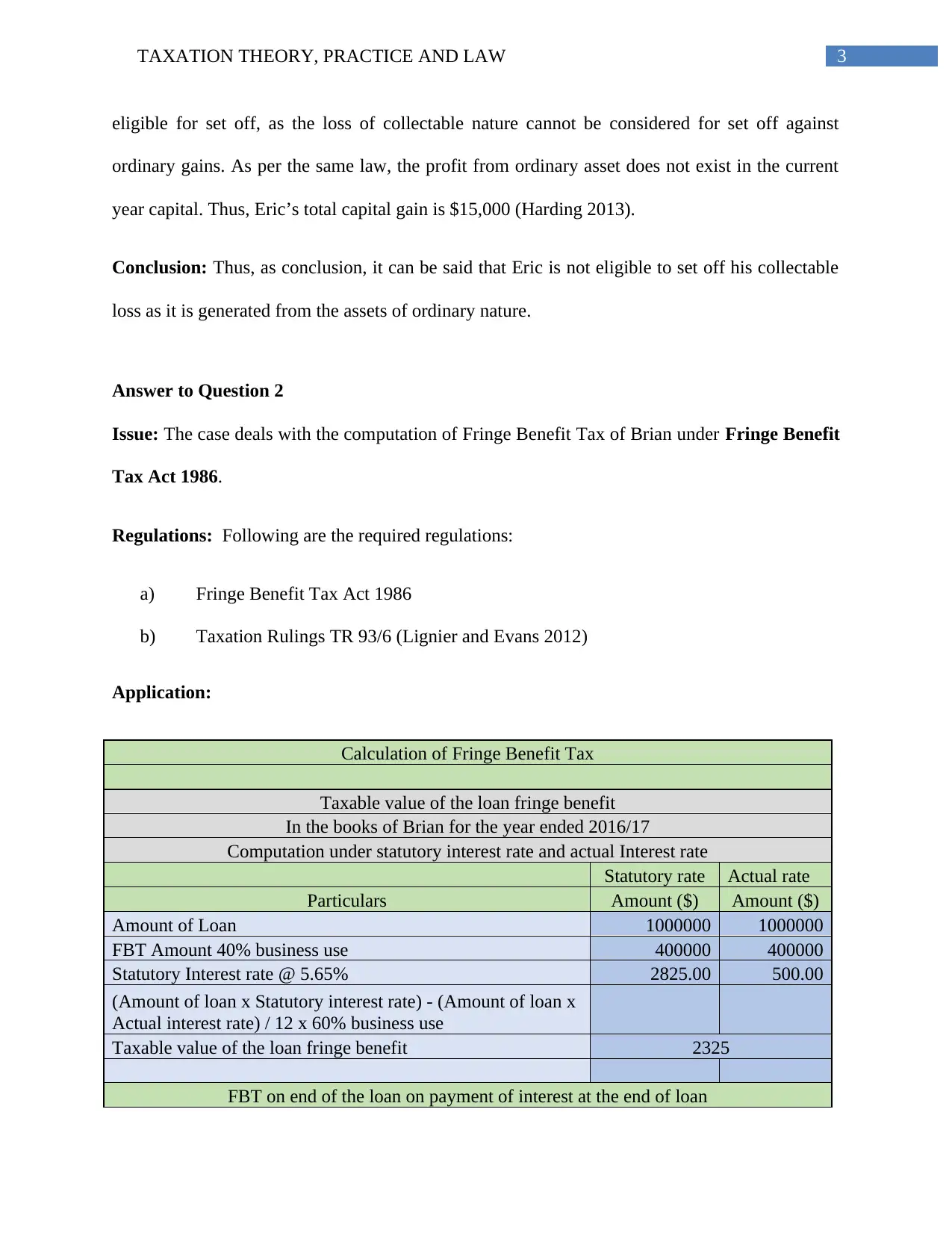
3TAXATION THEORY, PRACTICE AND LAW
eligible for set off, as the loss of collectable nature cannot be considered for set off against
ordinary gains. As per the same law, the profit from ordinary asset does not exist in the current
year capital. Thus, Eric’s total capital gain is $15,000 (Harding 2013).
Conclusion: Thus, as conclusion, it can be said that Eric is not eligible to set off his collectable
loss as it is generated from the assets of ordinary nature.
Answer to Question 2
Issue: The case deals with the computation of Fringe Benefit Tax of Brian under Fringe Benefit
Tax Act 1986.
Regulations: Following are the required regulations:
a) Fringe Benefit Tax Act 1986
b) Taxation Rulings TR 93/6 (Lignier and Evans 2012)
Application:
Calculation of Fringe Benefit Tax
Taxable value of the loan fringe benefit
In the books of Brian for the year ended 2016/17
Computation under statutory interest rate and actual Interest rate
Statutory rate Actual rate
Particulars Amount ($) Amount ($)
Amount of Loan 1000000 1000000
FBT Amount 40% business use 400000 400000
Statutory Interest rate @ 5.65% 2825.00 500.00
(Amount of loan x Statutory interest rate) - (Amount of loan x
Actual interest rate) / 12 x 60% business use
Taxable value of the loan fringe benefit 2325
FBT on end of the loan on payment of interest at the end of loan
eligible for set off, as the loss of collectable nature cannot be considered for set off against
ordinary gains. As per the same law, the profit from ordinary asset does not exist in the current
year capital. Thus, Eric’s total capital gain is $15,000 (Harding 2013).
Conclusion: Thus, as conclusion, it can be said that Eric is not eligible to set off his collectable
loss as it is generated from the assets of ordinary nature.
Answer to Question 2
Issue: The case deals with the computation of Fringe Benefit Tax of Brian under Fringe Benefit
Tax Act 1986.
Regulations: Following are the required regulations:
a) Fringe Benefit Tax Act 1986
b) Taxation Rulings TR 93/6 (Lignier and Evans 2012)
Application:
Calculation of Fringe Benefit Tax
Taxable value of the loan fringe benefit
In the books of Brian for the year ended 2016/17
Computation under statutory interest rate and actual Interest rate
Statutory rate Actual rate
Particulars Amount ($) Amount ($)
Amount of Loan 1000000 1000000
FBT Amount 40% business use 400000 400000
Statutory Interest rate @ 5.65% 2825.00 500.00
(Amount of loan x Statutory interest rate) - (Amount of loan x
Actual interest rate) / 12 x 60% business use
Taxable value of the loan fringe benefit 2325
FBT on end of the loan on payment of interest at the end of loan
Paraphrase This Document
Need a fresh take? Get an instant paraphrase of this document with our AI Paraphraser
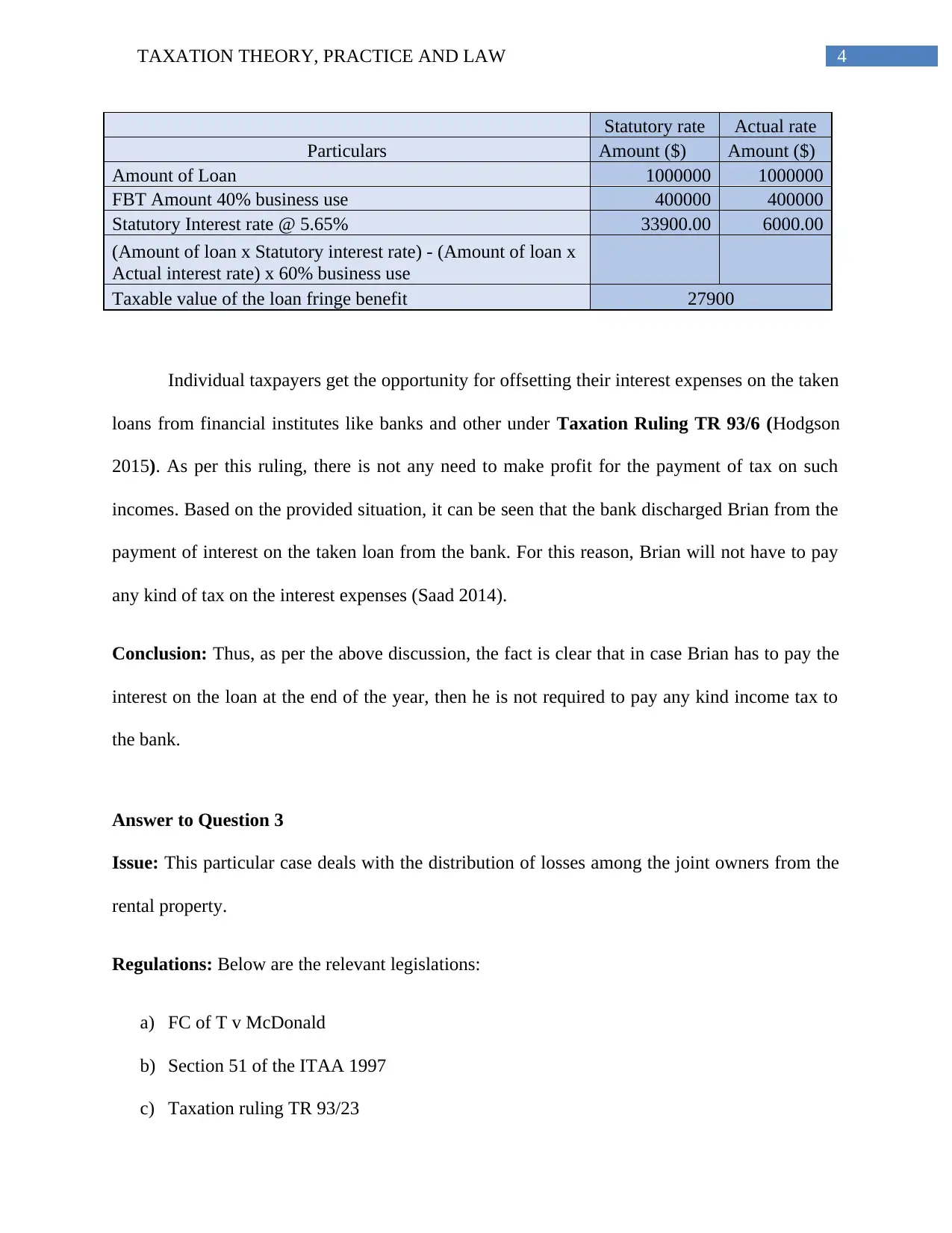
4TAXATION THEORY, PRACTICE AND LAW
Statutory rate Actual rate
Particulars Amount ($) Amount ($)
Amount of Loan 1000000 1000000
FBT Amount 40% business use 400000 400000
Statutory Interest rate @ 5.65% 33900.00 6000.00
(Amount of loan x Statutory interest rate) - (Amount of loan x
Actual interest rate) x 60% business use
Taxable value of the loan fringe benefit 27900
Individual taxpayers get the opportunity for offsetting their interest expenses on the taken
loans from financial institutes like banks and other under Taxation Ruling TR 93/6 (Hodgson
2015). As per this ruling, there is not any need to make profit for the payment of tax on such
incomes. Based on the provided situation, it can be seen that the bank discharged Brian from the
payment of interest on the taken loan from the bank. For this reason, Brian will not have to pay
any kind of tax on the interest expenses (Saad 2014).
Conclusion: Thus, as per the above discussion, the fact is clear that in case Brian has to pay the
interest on the loan at the end of the year, then he is not required to pay any kind income tax to
the bank.
Answer to Question 3
Issue: This particular case deals with the distribution of losses among the joint owners from the
rental property.
Regulations: Below are the relevant legislations:
a) FC of T v McDonald
b) Section 51 of the ITAA 1997
c) Taxation ruling TR 93/23
Statutory rate Actual rate
Particulars Amount ($) Amount ($)
Amount of Loan 1000000 1000000
FBT Amount 40% business use 400000 400000
Statutory Interest rate @ 5.65% 33900.00 6000.00
(Amount of loan x Statutory interest rate) - (Amount of loan x
Actual interest rate) x 60% business use
Taxable value of the loan fringe benefit 27900
Individual taxpayers get the opportunity for offsetting their interest expenses on the taken
loans from financial institutes like banks and other under Taxation Ruling TR 93/6 (Hodgson
2015). As per this ruling, there is not any need to make profit for the payment of tax on such
incomes. Based on the provided situation, it can be seen that the bank discharged Brian from the
payment of interest on the taken loan from the bank. For this reason, Brian will not have to pay
any kind of tax on the interest expenses (Saad 2014).
Conclusion: Thus, as per the above discussion, the fact is clear that in case Brian has to pay the
interest on the loan at the end of the year, then he is not required to pay any kind income tax to
the bank.
Answer to Question 3
Issue: This particular case deals with the distribution of losses among the joint owners from the
rental property.
Regulations: Below are the relevant legislations:
a) FC of T v McDonald
b) Section 51 of the ITAA 1997
c) Taxation ruling TR 93/23
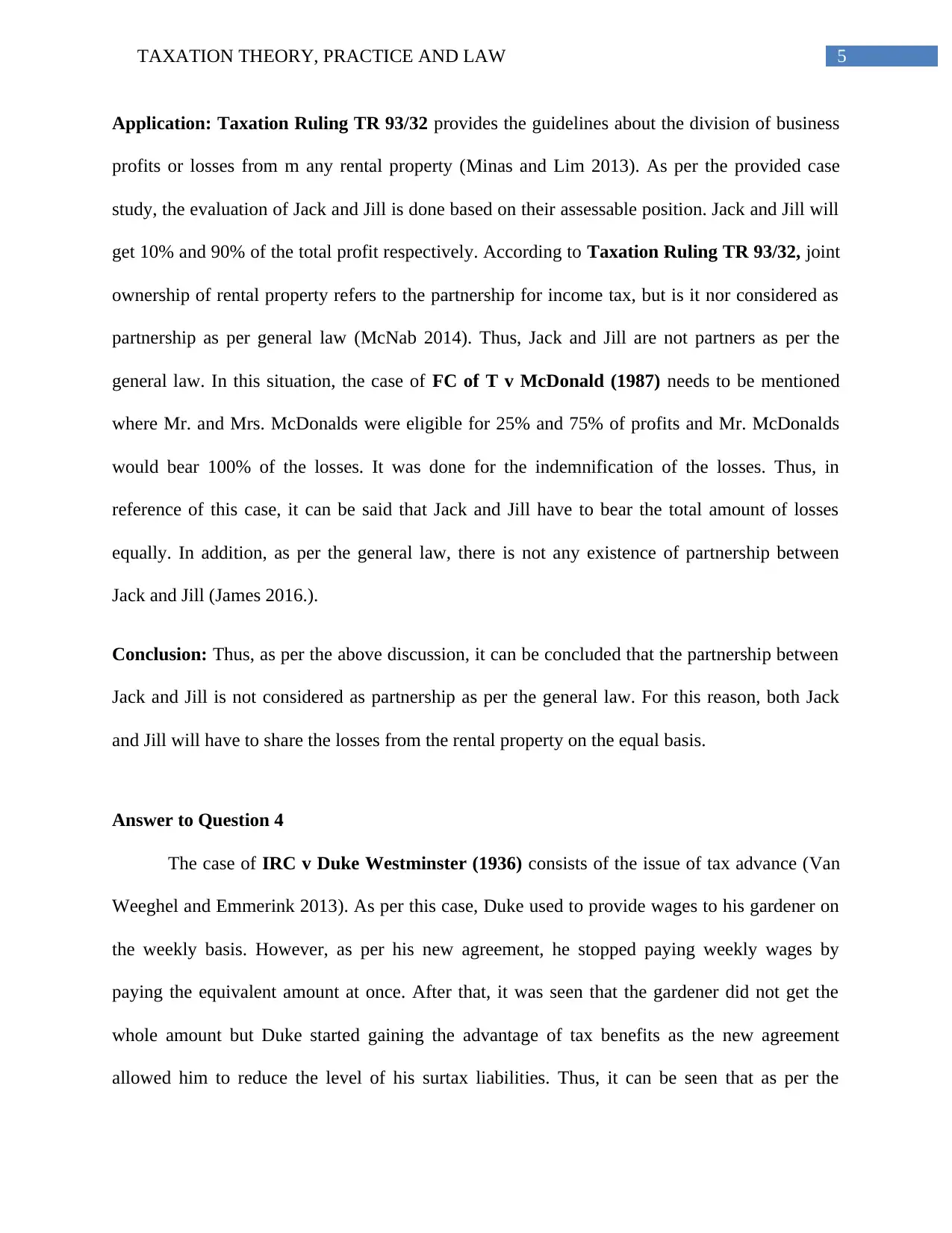
5TAXATION THEORY, PRACTICE AND LAW
Application: Taxation Ruling TR 93/32 provides the guidelines about the division of business
profits or losses from m any rental property (Minas and Lim 2013). As per the provided case
study, the evaluation of Jack and Jill is done based on their assessable position. Jack and Jill will
get 10% and 90% of the total profit respectively. According to Taxation Ruling TR 93/32, joint
ownership of rental property refers to the partnership for income tax, but is it nor considered as
partnership as per general law (McNab 2014). Thus, Jack and Jill are not partners as per the
general law. In this situation, the case of FC of T v McDonald (1987) needs to be mentioned
where Mr. and Mrs. McDonalds were eligible for 25% and 75% of profits and Mr. McDonalds
would bear 100% of the losses. It was done for the indemnification of the losses. Thus, in
reference of this case, it can be said that Jack and Jill have to bear the total amount of losses
equally. In addition, as per the general law, there is not any existence of partnership between
Jack and Jill (James 2016.).
Conclusion: Thus, as per the above discussion, it can be concluded that the partnership between
Jack and Jill is not considered as partnership as per the general law. For this reason, both Jack
and Jill will have to share the losses from the rental property on the equal basis.
Answer to Question 4
The case of IRC v Duke Westminster (1936) consists of the issue of tax advance (Van
Weeghel and Emmerink 2013). As per this case, Duke used to provide wages to his gardener on
the weekly basis. However, as per his new agreement, he stopped paying weekly wages by
paying the equivalent amount at once. After that, it was seen that the gardener did not get the
whole amount but Duke started gaining the advantage of tax benefits as the new agreement
allowed him to reduce the level of his surtax liabilities. Thus, it can be seen that as per the
Application: Taxation Ruling TR 93/32 provides the guidelines about the division of business
profits or losses from m any rental property (Minas and Lim 2013). As per the provided case
study, the evaluation of Jack and Jill is done based on their assessable position. Jack and Jill will
get 10% and 90% of the total profit respectively. According to Taxation Ruling TR 93/32, joint
ownership of rental property refers to the partnership for income tax, but is it nor considered as
partnership as per general law (McNab 2014). Thus, Jack and Jill are not partners as per the
general law. In this situation, the case of FC of T v McDonald (1987) needs to be mentioned
where Mr. and Mrs. McDonalds were eligible for 25% and 75% of profits and Mr. McDonalds
would bear 100% of the losses. It was done for the indemnification of the losses. Thus, in
reference of this case, it can be said that Jack and Jill have to bear the total amount of losses
equally. In addition, as per the general law, there is not any existence of partnership between
Jack and Jill (James 2016.).
Conclusion: Thus, as per the above discussion, it can be concluded that the partnership between
Jack and Jill is not considered as partnership as per the general law. For this reason, both Jack
and Jill will have to share the losses from the rental property on the equal basis.
Answer to Question 4
The case of IRC v Duke Westminster (1936) consists of the issue of tax advance (Van
Weeghel and Emmerink 2013). As per this case, Duke used to provide wages to his gardener on
the weekly basis. However, as per his new agreement, he stopped paying weekly wages by
paying the equivalent amount at once. After that, it was seen that the gardener did not get the
whole amount but Duke started gaining the advantage of tax benefits as the new agreement
allowed him to reduce the level of his surtax liabilities. Thus, it can be seen that as per the
⊘ This is a preview!⊘
Do you want full access?
Subscribe today to unlock all pages.

Trusted by 1+ million students worldwide
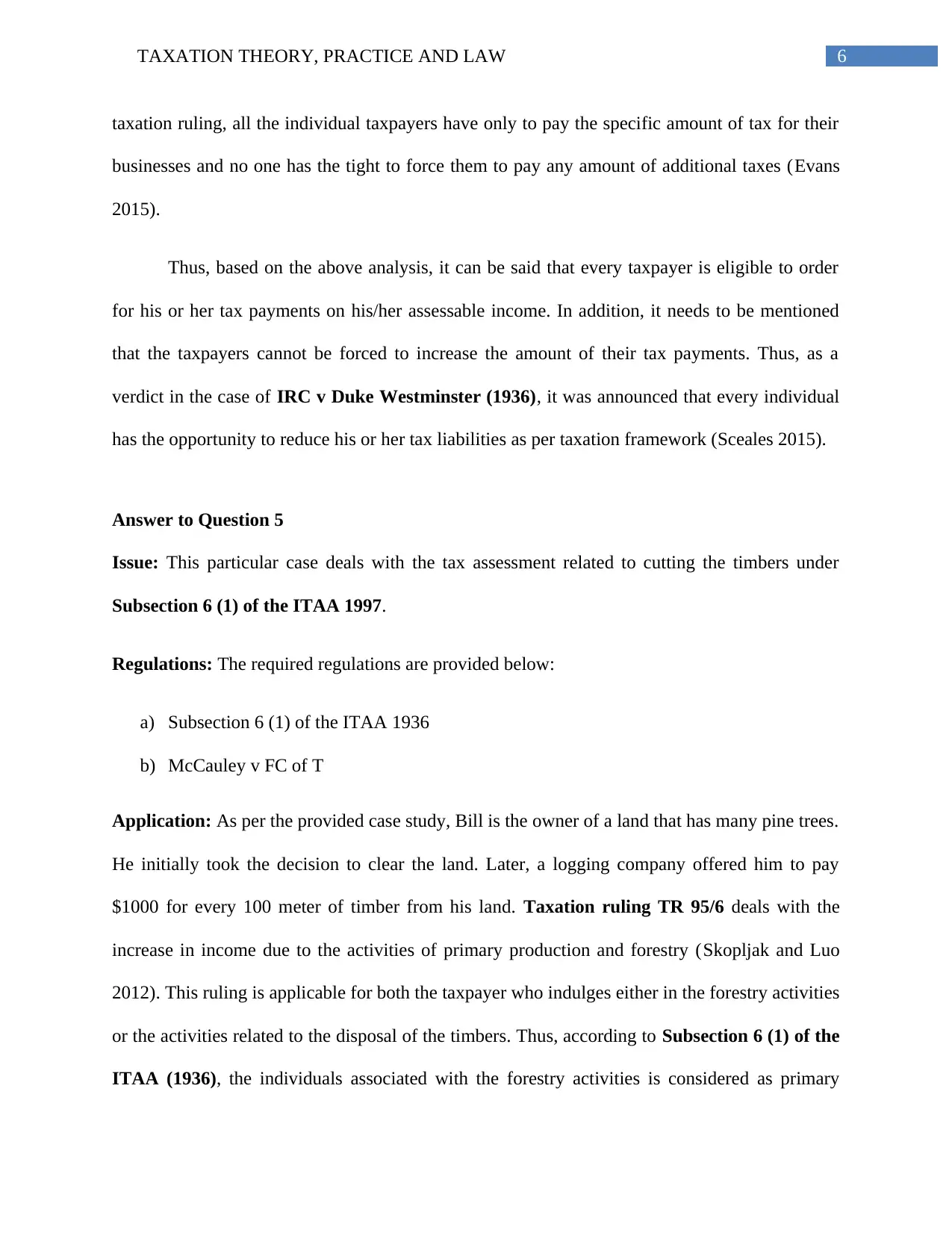
6TAXATION THEORY, PRACTICE AND LAW
taxation ruling, all the individual taxpayers have only to pay the specific amount of tax for their
businesses and no one has the tight to force them to pay any amount of additional taxes (Evans
2015).
Thus, based on the above analysis, it can be said that every taxpayer is eligible to order
for his or her tax payments on his/her assessable income. In addition, it needs to be mentioned
that the taxpayers cannot be forced to increase the amount of their tax payments. Thus, as a
verdict in the case of IRC v Duke Westminster (1936), it was announced that every individual
has the opportunity to reduce his or her tax liabilities as per taxation framework (Sceales 2015).
Answer to Question 5
Issue: This particular case deals with the tax assessment related to cutting the timbers under
Subsection 6 (1) of the ITAA 1997.
Regulations: The required regulations are provided below:
a) Subsection 6 (1) of the ITAA 1936
b) McCauley v FC of T
Application: As per the provided case study, Bill is the owner of a land that has many pine trees.
He initially took the decision to clear the land. Later, a logging company offered him to pay
$1000 for every 100 meter of timber from his land. Taxation ruling TR 95/6 deals with the
increase in income due to the activities of primary production and forestry (Skopljak and Luo
2012). This ruling is applicable for both the taxpayer who indulges either in the forestry activities
or the activities related to the disposal of the timbers. Thus, according to Subsection 6 (1) of the
ITAA (1936), the individuals associated with the forestry activities is considered as primary
taxation ruling, all the individual taxpayers have only to pay the specific amount of tax for their
businesses and no one has the tight to force them to pay any amount of additional taxes (Evans
2015).
Thus, based on the above analysis, it can be said that every taxpayer is eligible to order
for his or her tax payments on his/her assessable income. In addition, it needs to be mentioned
that the taxpayers cannot be forced to increase the amount of their tax payments. Thus, as a
verdict in the case of IRC v Duke Westminster (1936), it was announced that every individual
has the opportunity to reduce his or her tax liabilities as per taxation framework (Sceales 2015).
Answer to Question 5
Issue: This particular case deals with the tax assessment related to cutting the timbers under
Subsection 6 (1) of the ITAA 1997.
Regulations: The required regulations are provided below:
a) Subsection 6 (1) of the ITAA 1936
b) McCauley v FC of T
Application: As per the provided case study, Bill is the owner of a land that has many pine trees.
He initially took the decision to clear the land. Later, a logging company offered him to pay
$1000 for every 100 meter of timber from his land. Taxation ruling TR 95/6 deals with the
increase in income due to the activities of primary production and forestry (Skopljak and Luo
2012). This ruling is applicable for both the taxpayer who indulges either in the forestry activities
or the activities related to the disposal of the timbers. Thus, according to Subsection 6 (1) of the
ITAA (1936), the individuals associated with the forestry activities is considered as primary
Paraphrase This Document
Need a fresh take? Get an instant paraphrase of this document with our AI Paraphraser
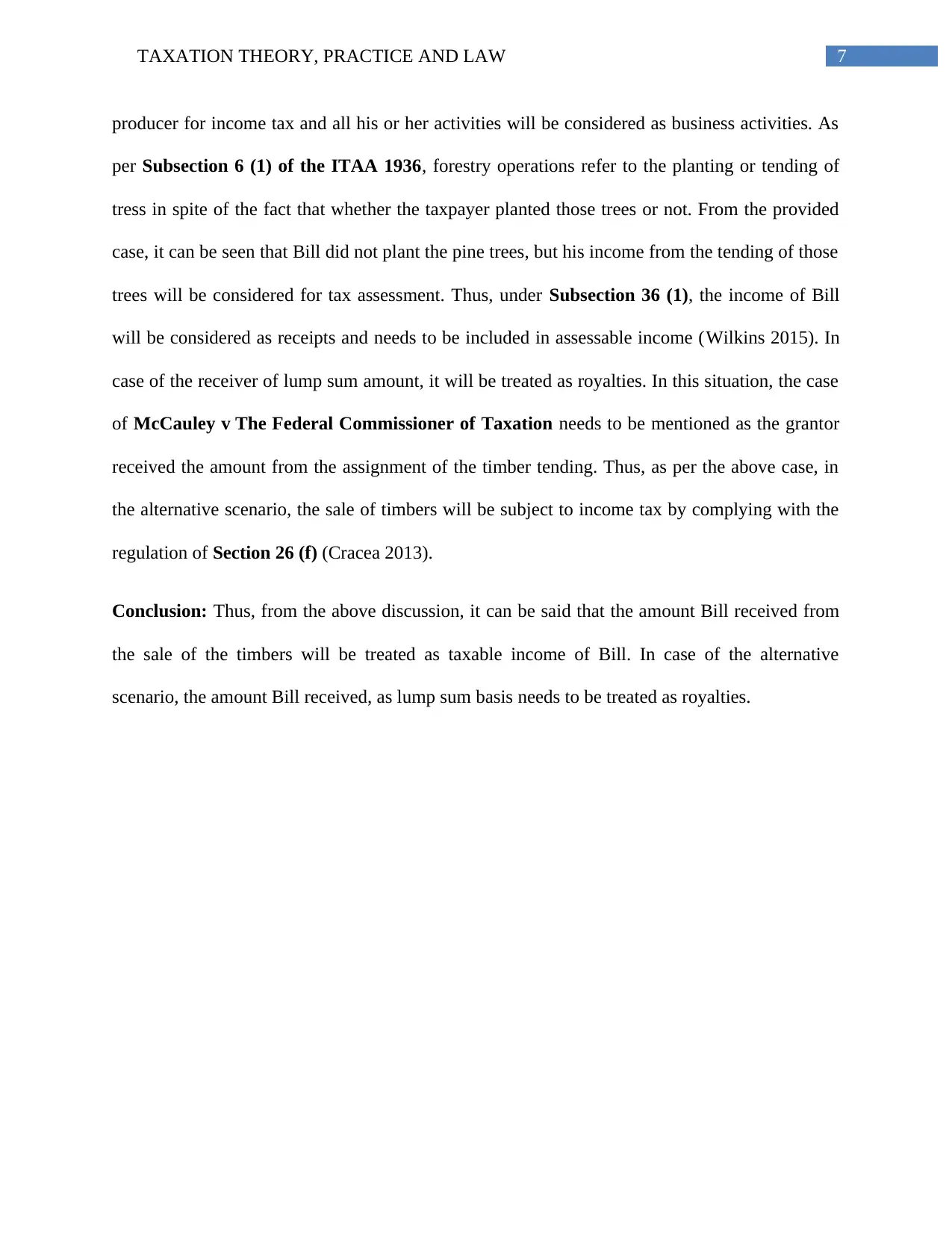
7TAXATION THEORY, PRACTICE AND LAW
producer for income tax and all his or her activities will be considered as business activities. As
per Subsection 6 (1) of the ITAA 1936, forestry operations refer to the planting or tending of
tress in spite of the fact that whether the taxpayer planted those trees or not. From the provided
case, it can be seen that Bill did not plant the pine trees, but his income from the tending of those
trees will be considered for tax assessment. Thus, under Subsection 36 (1), the income of Bill
will be considered as receipts and needs to be included in assessable income (Wilkins 2015). In
case of the receiver of lump sum amount, it will be treated as royalties. In this situation, the case
of McCauley v The Federal Commissioner of Taxation needs to be mentioned as the grantor
received the amount from the assignment of the timber tending. Thus, as per the above case, in
the alternative scenario, the sale of timbers will be subject to income tax by complying with the
regulation of Section 26 (f) (Cracea 2013).
Conclusion: Thus, from the above discussion, it can be said that the amount Bill received from
the sale of the timbers will be treated as taxable income of Bill. In case of the alternative
scenario, the amount Bill received, as lump sum basis needs to be treated as royalties.
producer for income tax and all his or her activities will be considered as business activities. As
per Subsection 6 (1) of the ITAA 1936, forestry operations refer to the planting or tending of
tress in spite of the fact that whether the taxpayer planted those trees or not. From the provided
case, it can be seen that Bill did not plant the pine trees, but his income from the tending of those
trees will be considered for tax assessment. Thus, under Subsection 36 (1), the income of Bill
will be considered as receipts and needs to be included in assessable income (Wilkins 2015). In
case of the receiver of lump sum amount, it will be treated as royalties. In this situation, the case
of McCauley v The Federal Commissioner of Taxation needs to be mentioned as the grantor
received the amount from the assignment of the timber tending. Thus, as per the above case, in
the alternative scenario, the sale of timbers will be subject to income tax by complying with the
regulation of Section 26 (f) (Cracea 2013).
Conclusion: Thus, from the above discussion, it can be said that the amount Bill received from
the sale of the timbers will be treated as taxable income of Bill. In case of the alternative
scenario, the amount Bill received, as lump sum basis needs to be treated as royalties.
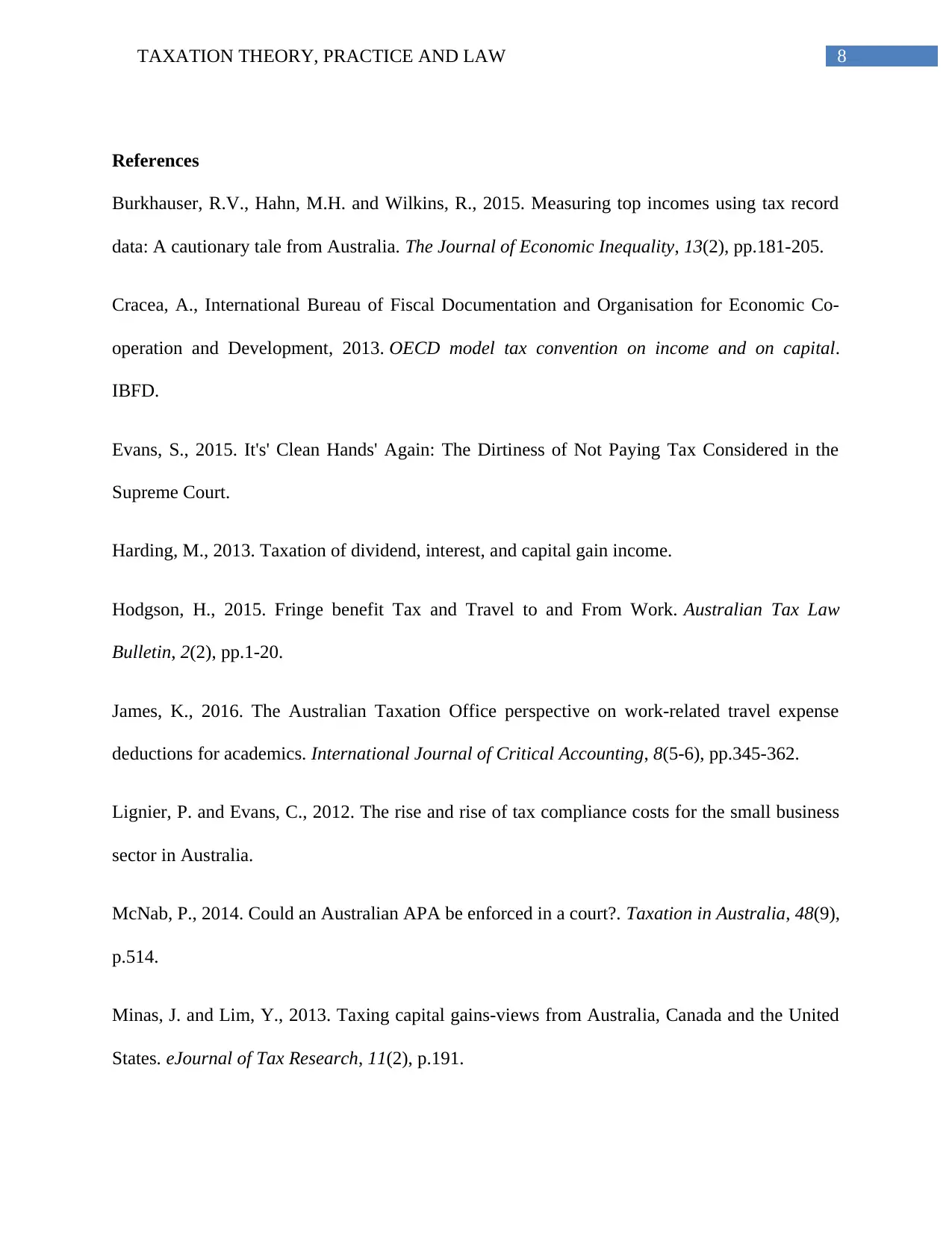
8TAXATION THEORY, PRACTICE AND LAW
References
Burkhauser, R.V., Hahn, M.H. and Wilkins, R., 2015. Measuring top incomes using tax record
data: A cautionary tale from Australia. The Journal of Economic Inequality, 13(2), pp.181-205.
Cracea, A., International Bureau of Fiscal Documentation and Organisation for Economic Co-
operation and Development, 2013. OECD model tax convention on income and on capital.
IBFD.
Evans, S., 2015. It's' Clean Hands' Again: The Dirtiness of Not Paying Tax Considered in the
Supreme Court.
Harding, M., 2013. Taxation of dividend, interest, and capital gain income.
Hodgson, H., 2015. Fringe benefit Tax and Travel to and From Work. Australian Tax Law
Bulletin, 2(2), pp.1-20.
James, K., 2016. The Australian Taxation Office perspective on work-related travel expense
deductions for academics. International Journal of Critical Accounting, 8(5-6), pp.345-362.
Lignier, P. and Evans, C., 2012. The rise and rise of tax compliance costs for the small business
sector in Australia.
McNab, P., 2014. Could an Australian APA be enforced in a court?. Taxation in Australia, 48(9),
p.514.
Minas, J. and Lim, Y., 2013. Taxing capital gains-views from Australia, Canada and the United
States. eJournal of Tax Research, 11(2), p.191.
References
Burkhauser, R.V., Hahn, M.H. and Wilkins, R., 2015. Measuring top incomes using tax record
data: A cautionary tale from Australia. The Journal of Economic Inequality, 13(2), pp.181-205.
Cracea, A., International Bureau of Fiscal Documentation and Organisation for Economic Co-
operation and Development, 2013. OECD model tax convention on income and on capital.
IBFD.
Evans, S., 2015. It's' Clean Hands' Again: The Dirtiness of Not Paying Tax Considered in the
Supreme Court.
Harding, M., 2013. Taxation of dividend, interest, and capital gain income.
Hodgson, H., 2015. Fringe benefit Tax and Travel to and From Work. Australian Tax Law
Bulletin, 2(2), pp.1-20.
James, K., 2016. The Australian Taxation Office perspective on work-related travel expense
deductions for academics. International Journal of Critical Accounting, 8(5-6), pp.345-362.
Lignier, P. and Evans, C., 2012. The rise and rise of tax compliance costs for the small business
sector in Australia.
McNab, P., 2014. Could an Australian APA be enforced in a court?. Taxation in Australia, 48(9),
p.514.
Minas, J. and Lim, Y., 2013. Taxing capital gains-views from Australia, Canada and the United
States. eJournal of Tax Research, 11(2), p.191.
⊘ This is a preview!⊘
Do you want full access?
Subscribe today to unlock all pages.

Trusted by 1+ million students worldwide
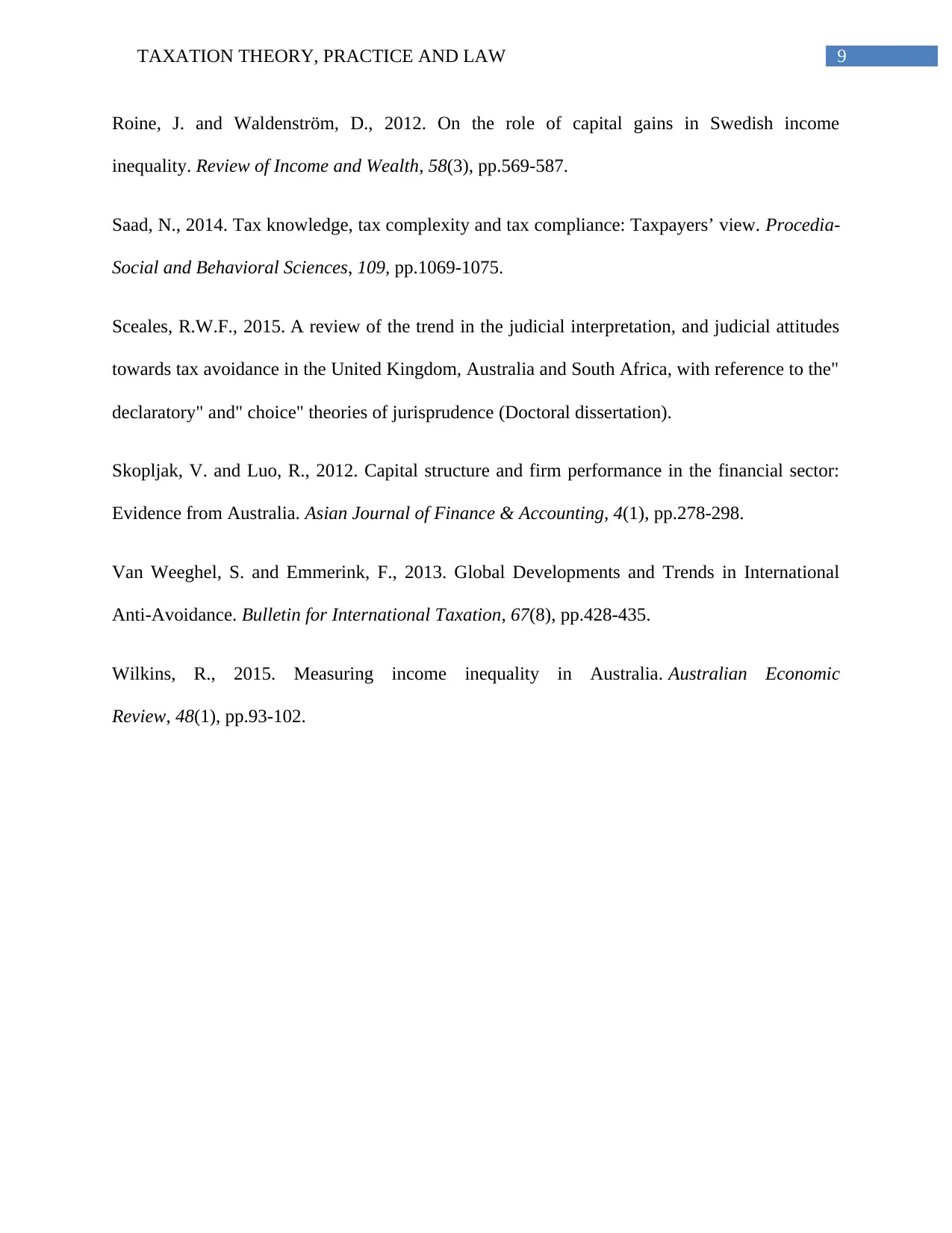
9TAXATION THEORY, PRACTICE AND LAW
Roine, J. and Waldenström, D., 2012. On the role of capital gains in Swedish income
inequality. Review of Income and Wealth, 58(3), pp.569-587.
Saad, N., 2014. Tax knowledge, tax complexity and tax compliance: Taxpayers’ view. Procedia-
Social and Behavioral Sciences, 109, pp.1069-1075.
Sceales, R.W.F., 2015. A review of the trend in the judicial interpretation, and judicial attitudes
towards tax avoidance in the United Kingdom, Australia and South Africa, with reference to the"
declaratory" and" choice" theories of jurisprudence (Doctoral dissertation).
Skopljak, V. and Luo, R., 2012. Capital structure and firm performance in the financial sector:
Evidence from Australia. Asian Journal of Finance & Accounting, 4(1), pp.278-298.
Van Weeghel, S. and Emmerink, F., 2013. Global Developments and Trends in International
Anti-Avoidance. Bulletin for International Taxation, 67(8), pp.428-435.
Wilkins, R., 2015. Measuring income inequality in Australia. Australian Economic
Review, 48(1), pp.93-102.
Roine, J. and Waldenström, D., 2012. On the role of capital gains in Swedish income
inequality. Review of Income and Wealth, 58(3), pp.569-587.
Saad, N., 2014. Tax knowledge, tax complexity and tax compliance: Taxpayers’ view. Procedia-
Social and Behavioral Sciences, 109, pp.1069-1075.
Sceales, R.W.F., 2015. A review of the trend in the judicial interpretation, and judicial attitudes
towards tax avoidance in the United Kingdom, Australia and South Africa, with reference to the"
declaratory" and" choice" theories of jurisprudence (Doctoral dissertation).
Skopljak, V. and Luo, R., 2012. Capital structure and firm performance in the financial sector:
Evidence from Australia. Asian Journal of Finance & Accounting, 4(1), pp.278-298.
Van Weeghel, S. and Emmerink, F., 2013. Global Developments and Trends in International
Anti-Avoidance. Bulletin for International Taxation, 67(8), pp.428-435.
Wilkins, R., 2015. Measuring income inequality in Australia. Australian Economic
Review, 48(1), pp.93-102.
1 out of 10
Related Documents
Your All-in-One AI-Powered Toolkit for Academic Success.
+13062052269
info@desklib.com
Available 24*7 on WhatsApp / Email
![[object Object]](/_next/static/media/star-bottom.7253800d.svg)
Unlock your academic potential
Copyright © 2020–2025 A2Z Services. All Rights Reserved. Developed and managed by ZUCOL.





